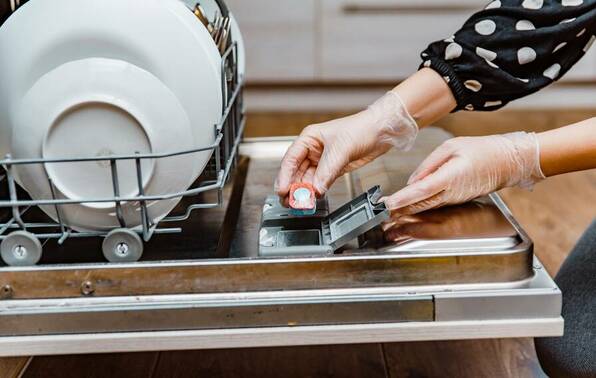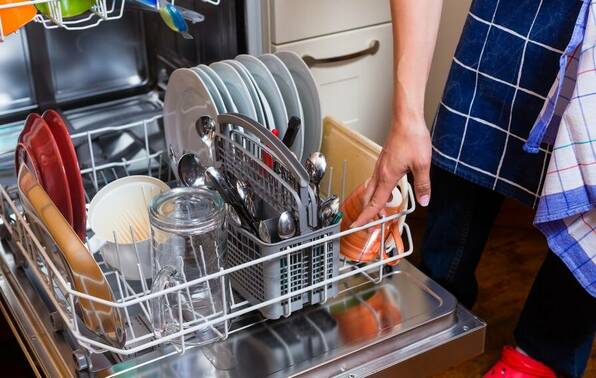Dishwashers
We've tested freestanding, built-in and integrated dishwashers, so you know what to consider next time you buy a dishwasher, including models from Bosch, Haier, and Fisher & Paykel.
We've tested compact and standard dishwashers to find out which are the best at washing and drying.
Types of dishwashers
Dishwashers come in various shapes and sizes to suit different kitchens.
Freestanding dishwasher
This is the traditional dishwasher type. These dishwashers are designed to stand freely, not attached. They come with a worktop and are great if you don’t have enough space to fit a dishwasher under a bench. They often come with a removable worktop.
Built-in dishwasher
These models fasten under your bench and must be installed in an enclosed space and anchored to prevent them tipping over. Because only the front of the dishwasher is visible, they don’t have finished panels on the sides or top. They come with many finish options including white, stainless steel and black.
Semi-integrated dishwasher
These dishwashers are a type of built-in and are installed the same way. The difference is in their front fascia (the door). Semi-integrated dishwasher models can be customised with a front panel that matches the rest of your cabinetry. The only part that’s still visible is the control panel and handle.
Fully integrated dishwasher
This is step up from semi-integrated models. The main difference being you can fully customise the front of the dishwasher with a panel to match your cabinetry. This means the controls need to be on the top or inside of the door. Some models shine a light on the floor to tell you when the wash is finished or to project the remaining time. This type of model is “invisible” as it just looks like another kitchen cupboard.
We often test the built-in version of an integrated model. But you can expect integrated dishwashers to perform the same as our results, as the difference is only in the front panel. Integrated dishwashers are often indicated by an ‘i’ in their model name.
Drawer dishwasher
These dishwashers are microwave-sized and are fixed into a cavity, like a built-in dishwasher, but aren’t as tall. They come in single drawer and double drawer options (two single drawers stacked), with a double drawer model having similar dimensions to a standard dishwasher. Fisher & Paykel is the biggest supplier of these models in New Zealand (though you can find other brands on the market).
Slimline dishwasher
As the name suggests these are slim dishwashers. They’re often 45cm wide, but any model thinner than 60cm is considered slimline. These are a great option for small kitchens and allow you to wash taller items that won’t fit in a drawer model.
Benchtop/portable dishwasher
This type of dishwasher is about the size of a microwave and portable (though they can be heavy) and sits on your countertop. A pro is they require minimal installation (they usually just attach to your taps and drain into the sink). Their downsides are that they can’t fit many dishes or big items and take up space on your bench. We don’t test benchtop dishwashers as they aren’t common in New Zealand.
What to look for when buying a dishwasher
Dimensions
Dishwasher size: A lot of 12- to 16-place setting models need roughly the same amount of under bench space (82–85cm height, 60cm width and 55cm–65cm depth). Make sure you include ventilation space requirements when measuring your space. If you’re looking for a dishwasher to squeeze into a small space, a compact or slimline model might best.
Dishwasher capacity: The dishwashers we’re reviewed currently range from 7 to 16 place settings. Overfilling a dishwasher with extra crockery and cutlery reduces wash performance.
Note: Place setting refers to the kitchenware used by one person, such as plates, glasses, and cutlery.
Flexible loading
-
Adjustable top basket: This dishwasher rack is essential if you want to wash champagne flutes or other tall wine glasses, or plan to wash very large plates in the lower basket. Some models let you lower one side of the basket, so you can wash tall glasses and large plates at the same time.
Removable or folding tines allow large or awkwardly shaped objects to fit in the baskets. Watch out for short tines – plates can fall over onto each other and prevent a good wash. Take along a few pieces of your everyday dinnerware, such as a large plate, a deep bowl and a long-stemmed glass. See how they fit – check that the baskets can close and the spray arms can spin without hitting anything.
Anti-nesting grids: These grids fit over the dishwasher cutlery basket to prevent cutlery bunching together. Removable grids are more versatile and easier to use.
Cutlery tray: Here's an innovation in some models you'll either love or hate. Critics find it time consuming and fiddly to load, because each piece of cutlery has to go in its own slot – the right way round. And it can prevent tall glasses from fitting, unless the tray is removed. A basket may be offered as an alternative or in addition to a tray.
Settings
- Program options and features: What do you want your dishwasher to do? The options vary. A low-temperature wash saves power, and lets you take advantage of the new enzyme detergents. A delicate cycle is useful for fragile items. A fast-wash function is efficient if you've pre-rinsed the plates to remove the worst of the grime. A half-load option reduces the amount of detergent, power and water required.
- Cycle time: A normal dishwasher cycle takes around 2 to 2.5 hours. Some models have a fast cycle, and those with a hot connection will be quicker than those that heat the water themselves.
- Auto-sensing:An auto-sensing feature allows a dishwasher to analyse the water and assess how dirty your dishes are. It then adjusts water temperature and the length of time to suit. An auto-sensing mode is essentially an eco or efficient dishwasher wash.
-
Displays: It's helpful to see how soon the cycle will finish, or where to look to fix simple problems, such as blocked spray arms.
Other features
Additional features to consider when you're choosing a dishwasher.
- Anti-flooding devices: Worth having. Often fitted to the hose, to prevent your kitchen becoming awash if there's a leak.
- Concealed heaters: We can't see any difference in performance between concealed and exposed heaters, though stray plastic items are more likely to melt onto an exposed element. If you must wash plastic, do larger pieces only, and in the top rack.
- Noise: If you're used to a 15-year-old dishwasher, you'll probably be astonished at how quiet the current models are. Machines that can wash at levels below 45dBA won't intrude too much on your post-dinner chat.
-
Style: The right look can be a key factor, and a stylish dishwasher isn’t hard to come by now. Stainless steel dishwasher options are more common now than the traditional white. There’s even more customisation available with integrated dishwashers (often indicated by an ‘i' in the model name), which match their front panel to your kitchen cabinetry.
- Child proofing: Door locks and child-safe detergent dispensers can help prevent accidents.
- Filter: Make sure the filter is easy to remove and replace.
- Controls: Look for clearly labelled buttons and a display screen or rotary dial to indicate time remaining.
- Hot water connection: Dishwashers with a hot water connection may have a maximum water-inlet temperature, so may not be suitable for some hot water systems.

Best and worst dishwasher detergents
Choosing the right dishwasher detergent helps clean your dishes properly and protects your machine. We've tested over 20 different detergents to find the best ones.
Buying a secondhand dishwasher
Buying a secondhand dishwasher can be a bit of a gamble – you might end up with a seldom-used gem or a problematic monster. Unless you really must go down the secondhand route, we think buying new when it comes to dishwashers is better.
If a secondhand dishwasher is your only (or preferred) option:
- stick to well-known, reliable dishwasher brands and models under 5 years old, as it'll be easier to get parts if anything needs fixing – see our reliability data for brands to look for
- check our discontinued models to see if we’ve tested the model you’re looking at it – this will give you an indication of how it would perform when new
- check the door seal is intact and that the door closes properly
- check all connections and drainage hoses are intact and in good condition
- look for any signs of rodent or insect infestation or damage, such as chew marks on hoses, especially if it’s been sitting unused for a while
- make sure the inside is free from rust, the filter is clean, and the baskets slide in and out easily
- check for recalls for that model – you can do this by checking the manufacturer’s website or check the Product Safety website.
- ask if there’s any documentation for the dishwasher, such as a manual or receipts
under the Electricity Act and its regulations, electrical appliances for sale must be safe – this applies to every way of selling an electrical appliance, new or used, regardless of where you buy it
if you buy a dishwasher from a secondhand dealer, then discover it’s faulty, you're covered by the Consumer Guarantees Act. If you buy privately, you're not.
Your rights if things go wrong
Bought something and want to take it back? Here's what you need to know about your rights. Consumer members can contact our advisers who will talk you through your rights, at Consumer Advice Line.
Buying new
If a product you buy is faulty or not of acceptable quality, you don’t have to put up with it. The Consumer Guarantees Act has got you covered – you don’t need a warranty. Here's more about how you can get a refund, repair or replacement for a faulty product.
Buying used
What are your consumer rights when purchasing a secondhand dishwasher? It depends on the seller. If you’re buying from a secondhand dealer (including those listed as ‘In-trade’ on Trade Me) and discover it’s faulty, you're covered by the Consumer Guarantees Act. The dishwasher should be of acceptable quality, fit for purpose and match the description. However, if you’re dealing with a private seller, you’re not covered by the act. Here's more info about your rights when buying second-hand goods.

10 items that should never go in your dishwasher
Ever wondered how you can tell what can and can’t go in the dishwasher? We explain the dishwasher safe symbols and 10 items that should never go in the dishwasher.
Energy rating labels

The Energy Rating Label has a scale of stars to show how energy efficient a model is, compared to other models of the same size or capacity.
More stars = more energy efficient.
The energy consumption figure is in kilowatt-hours (kWh), and you can use this figure and the cost (tariff) from your latest power bill to calculate how much this model will cost to run. The national average cost of a kWh in New Zealand is 29¢ (as reported by the Ministry of Business, Innovation and employment).
Lower kWh = cheaper to run.
Dishwasher annual energy consumption in kWh is based on standards testing and assumes 365 uses a year.
You should only compare star ratings of dishwashers with the same or similar capacities.
For information on energy ratings and how to use them, see our Energy Rating Labels explained article.
We've tested 119 dishwashers.
Find the right one for you.
AEG
.jpg&w=315&q=75)
AEG
.jpg&w=315&q=75)
.jpg&w=315&q=75)